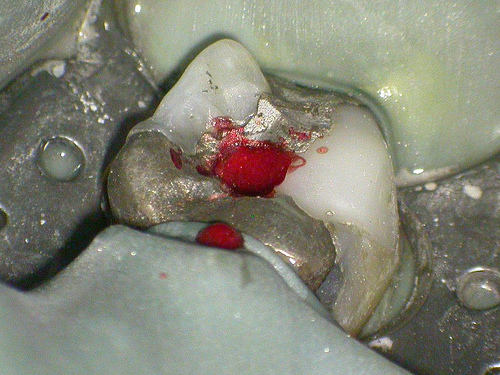Pulpitis is the inflammatory condition of the pulp (refer Diseases of the Pulp). Irreversible pulpitis is the inflammatory condition of the pulp, symptomatic or asymptomatic, caused by any noxious stimuli. It is characterized by persistent pain, and following are the types –
Acute –
- Abnormally responsive to cold
- Abnormally responsive to heat
Chronic –
- Asymptomatic with pulp exposure
- Hyperplastic pulpitis
- Internal resorption
img credit: flickr.com
Table of Contents:
Etiology of Irreversible Pulpitis
Symptoms of Irreversible Pulpitis
Diagnosis of Irreversible Pulpitis
Treatment of Irreversible Pulpitis
Causes of Irreversible Pulpitis
- Most commonly the bacterial involvement of pulp through dental caries
- Chemical, mechanical or thermal injuries that cause inflammation of the pulp
- Untreated reversible pulpitis can lead to irreversible pulpitis
Symptoms of Irreversible Pulpitis
- A rapid onset of pain when any stimulus like cold foods, or sweet food, pressure from packing of food into cavity, or pressure exerted by tongue, that results in congestion of the blood vessels of the pulp.
- The pain persists, even after the removal of the stimuli, and sometimes may come and go spontaneously without any particular known cause.
- The pain may be sharp, shooting or piercing in nature.
- Exacerbation of pain when the patient bends over or lies down.
- The pain may be referred to adjacent teeth sometimes, and also to ear if lower teeth are involved, and to temple region if the upper teeth are involved.
- In the later stages, the pain is described as throbbing, boring or gnawing type where the tooth is subjected to constant pressure as described by the patient.
- Relief of the pain is seen through cold water, or any cold substance.
- Pain would return back if the food packs into the cavity, or beneath a leaky filling.
Diagnosis of Irreversible Pulpitis
- Visual – Diagnosis through direct vision, showing a deep cavity involving the pulp, or any secondary caries under restoration, confirmed using a probe. If the probe is sent deep into the pulp, both pain and hemorrhage would be seen.
- Radiograph – It may show exposure of the pulp, caries under a filling, and deep cavity. The periapical area usually is normal, with some widening of the periodontal ligament sometimes.
- Percussion – Exudate in the pulpal cavity increases the intrapulpal pressure, which leads to tenderness on percussion of the tooth.
- Vitality tests – Hyperalgesic pulp responds more to cold stimulation, and persist even after the removal of the stimulus. Cold later tends to relieve the pain, when compared to heat which may intensify the response of the pulp due to contractile effect on the vessels.
Treatment of Irreversible Pulpitis
The treatment includes the complete removal of pulp i.e. pulpectomy, and placement of an intracanal medicament, like cresatin, eugenol, or formocresol.

As we often preach…..go see your dentist regularly. Those regular visits and checkups will likely save you tons of pain and money.
I have heard about pulpitis, but this is the place where I found some detailed information about the topic. Nice and thanks for sharing a helpful post in a very clear and concise way.
i read this blog its really helpful and i got many information.
My dentist said there is a very good chance I have irreversible pulpitis. The tooth has no signs of decay,but the pain is persistent. He said I show all the signs diagnostically but he was not 100 percent sure which tooth it was. He is referring me to a dentist who performs root canals.
My questions are two. Is there any way to be sure the pulpitis is irreversible and how can the doctor be sure of which tooth it is ?
Thanks, Chris
these is awesome,thanks Chris..